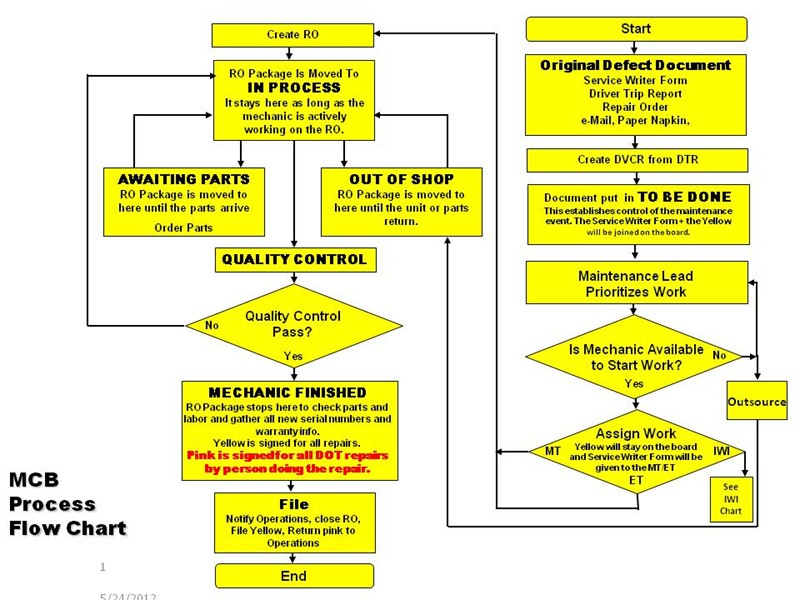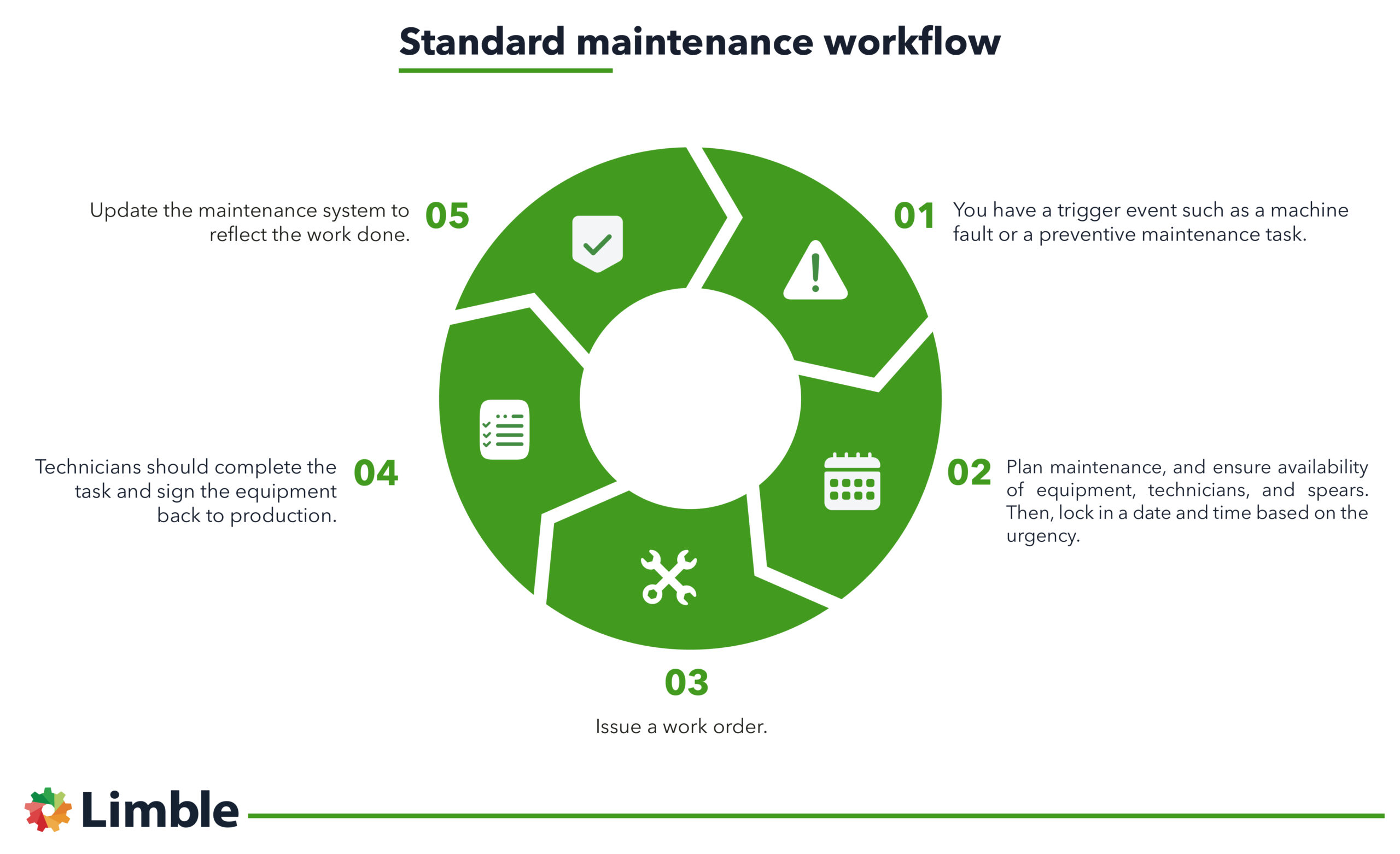An effective maintenance department is process-driven, using process mapping and flow charts to align maintenance processes with company objectives and optimize maintenance workflows for both efficiency and effectiveness.
In this post, we’ll explain what exactly process mapping is, show you how to apply it to your maintenance workflows, and discuss potential benefits.
Process mapping explained
Process mapping is a technique that uses flowcharts to explain the steps of a process. This technique helps team members to understand how to complete and optimize certain tasks without verbal explanations. It can be used in any business and industry, including maintenance.
Let’s check the six steps of process mapping.
Step #1 – Process identification
Start with a clear objective and scope of work for all change management tasks. This first step identifies the process to be mapped and the reasons for the exercise. Define what success will look like when complete, who the exercise will involve, and the business areas where the review will take place.
Step #2 – Gather data
This step interacts with all those using the process to understand what triggers it, the steps and people involved, interfaces between individuals and departments, and the duration of each task.
Step #3 – Map the process
Process mapping is a graphical representation of the chain of activities that begins with a trigger and ends in an outcome. It uses symbols to show the flow direction and all inputs, outputs, delays, and steps. However, you don’t have to be a process mapping expert – as long as you can show all paths, decisions, and loops from beginning to end.

Example of a process mapping. Source: Geaslin Group
Step #4 – Analyze your findings
Start working through your map to challenge every step. Use the 5 whys to challenge:
- What is being done?
- By whom?
- Where the task takes place?
- The time or point in the process?
- The method used to complete the task?
Step #5 – Modify and streamline
Steps three and four provide insight into unnecessary steps, parallel tasks that add no value, loop-backs that delay, and waiting times that you might avoid. Rearrange the process to remove all steps that add no value to the outcome, relocate actions for efficiency, and add new steps where required.
Step #6 – Review and manage
Implement the revised process with the support and understanding of your team. Monitor the outputs against the objectives stated in step one of the mapping process. Modify, fine-tune, and adjust, then issue the updated process for use.
Now that you’re familiar with the concept of process mapping, let’s show you how to apply it to your maintenance workflows.
What is a maintenance workflow?
Maintenance workflow is a step-by-step process on how maintenance tasks should be done. It is usually initiated by a certain trigger. Here are the steps of a standard maintenance workflow.

Let’s explain the above image with a concrete example:
- A reliability engineer receives oil sampling results from a lab indicating that the oil in a conveyor drive gearbox has deteriorated and requires changing.
- The engineer raises a work request for the gearbox’s oil and filter to be changed within the next two weeks and lodges this with maintenance.
- The maintenance planner checks:
- that the oil, seals, and filters are in stock
- determines the average hours needed for the task from maintenance history
- looks at the production plan to find and secure suitable downtime
- reviews the shift roster to ensure technical resources are available
- raises a task work order
- issues the task to the appropriate maintenance supervisor
- The maintenance supervisor assigns the task to a technician.
- The technician draws the oil and filters from inventory and books out the special tooling for the filter removal.
- The technician carries out the task, tests for leaks, and signs off the work order showing the used spares and consumables. They return the work order to their supervisor.
- The supervisor reviews the task, countersigns, and returns the work order to the maintenance planner.
- The maintenance planner updates the task in the maintenance system and resets the oil sampling frequency.
The benefits of mapping your maintenance workflows
Mapping your maintenance workflow provides six important benefits.

1. Business process improvement
Processes change over time, gathering extra steps and redundant tasks, with some processes set up poorly from the start. Mapping what is being done allows comparison against what others think is actually occurring. It also allows a graphical representation to make the process less abstract, highlighting unnecessary loops and steps.
Finally, it shows interfaces where unacceptable delays may occur when the process moves from one department to another. Identifying such inefficiencies is the first step towards improvement.
2. Workflow clarification
Mapping a workflow is useful to help outsiders and those involved to understand the sequence of events, their purpose, and expected duration. In our worked example above, the reliability engineer can review the workflow to understand how to proceed.
3. Role clarity
People carrying out a process may not always be clear on the requirements of their role, the interfaces required of them, and the procedures they need to follow to acquit their part. A new maintenance planner might review the workflow to understand the six steps they must undertake upon receipt of a work request.
4. Internal audit
Auditing for process compliance or regulatory breach is easier with a clearly defined workflow against which to measure observed work.
For instance, the audit may find that seals are not being drawn from stock when a gearbox oil change is called (despite the requirements of the work pack) or that the reliability engineer requested the work by email rather than formally raising a request.
5. Regulatory compliance and accountability
Where a regulatory breach has serious financial or legal repercussions, a process removes any doubt about the steps and procedures to follow and who must complete them. If a breach occurs, like gearbox oil being poured down the drain instead of placed in the oil recycling drum, the process pinpoints who to speak to.
6. Training improvements
A process identifies areas where an individual or team fails to meet expectations, and whether remedial training is required. If our maintenance planner constantly receives completed work orders that the supervisor hasn’t signed, the maintenance manager can address the issue using the process workflow as an example.
How to use CMMS to optimize your maintenance processes
A computerized maintenance management system (CMMS) provides immediate benefits for workflow optimization:
- It enforces process discipline by becoming the sole method of logging issues for maintenance rectification and avoiding informal procedures. The work order will not be raised if it’s not correctly logged in the CMMS.
- When logged, the prioritization of work requests enables the CMMS to schedule tasks for planned maintenance periods that are appropriate to the urgency. It also can raise notifications and alerts to senior staff for high-criticality items.
- By centralizing all data in one database, the CMMS ensures an audit trail from task initiation to completion, highlighting personnel actions, spares used, and contractors engaged.
- The maintenance program is automatically updated, with completed tasks and work-arising captured and the next-due dates and times advanced.
- The CMMS assists resource scheduling by indicating the number and specialty of all personnel required for planned maintenance shuts, tooling and spares required, and the time needed to complete the work. The in-service database within the CMMS allows data mining and analysis to identify efficiency metrics for continuous improvement initiatives.
- The CMMS allows you to quickly create, store, and access standard operating procedures, maintenance checklists, and safety guidelines which are key documents for standardizing maintenance work.
Other useful methods for maintenance workflow optimization
There are numerous practical steps that a maintenance organization can take for process optimization.
Kitting
A tactic used in the preparation of a maintenance task. It comprises the assembly of a kit of the spares, tools, and consumables required to acquit the work.
Store personnel carry-out kits ahead of the maintenance date once the task is entered, identifying the kit against the work order number and quarantining the kit to ensure it is available when the technician requests it. Kitting makes the technician more efficient on maintenance day while ensuring all resources are available.
Move asset care tasks to operators
Moving asset care tasks to operators provides three benefits to a business. It helps remove any us-versus-them issues between maintenance and production, ensures important and frequent tasks like cleaning and lubrication are done rather than ignored by maintenance staff, and assists in maintaining equipment reliability and design life achievement.
Identify and group tasks
Identify and group tasks or procedures being carried out at different times or by multiple people in different areas. Grouping increases efficiency and streamlines processes.
Provide portable digital devices
Provide portable devices to place the maintenance documentation where the maintenance tasks are underway. Digitalization of documents maintains version control and eliminates paper copies from compromising quality management systems; it also prevents travel time by technicians to access centrally located computers or paper manuals.
Start making improvements today
Efficient maintenance systems comprise multiple processes that need to be aligned and streamlined. By mapping each process and removing redundancies, overlaps, and unnecessary steps, you will optimize your maintenance workflow, make your employees more effective, reduce confusion, and save your business a lot of time and money.
Schedule a demo or start a free trial to see how Limble CMMS can help you with the optimization of your maintenance workflows.
The Essential Guide to CMMS
The Essential Guide to CMMS

